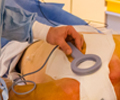Tag Archives: cardiac resynchronisation therapy
July 2022 Br J Cardiol 2022;29(suppl 2):S13–S16 doi:10.5837/bjc.2022.s08
Guidance on lifestyle, rehabilitation and devices in heart failure patients
Savvas Hadjiphilippou, Rebecca Lane

Introduction The 2021 European Society of Cardiology Congress saw the release of an update of the ESC guidelines for the diagnosis and treatment of acute and chronic heart failure (HF).1 This timely and comprehensive new set of guidelines is particularly noteworthy because of its inclusion of the Patient Forum as full members of the task force; a first for ESC HF guidance. HF management programmes Evident within the updated guidance is an emphasis on putting patients at the centre of HF care and empowering them to take ownership of their condition. Since the 2016 ESC HF guidelines2 were published, a growing body of evidence has placed increa
January 2022 Br J Cardiol 2022;29:40 doi:10.5837/bjc.2022.006
Correspondence: Improving DVLA advice upon discharge after cardiac device implantation
Arsalan Khalil, Tamara Naneishvili, Abigail Mayo-Evans, James Glancy

Following the article by Drs Inderjeet Bharaj et al.4 asking whether the medical profession is doing enough to give patients appropriate advice about driving after certain cardiac conditions, we are writing to share our own protocol. Hereford County Hospital is a 208-bed district general hospital that implants around 200–250 cardiac devices yearly, including complex cardiac devices, such as implantable cardiac defibrillator (ICD) and cardiac resynchronisation therapy (CRT) devices. Many implants are in emergency inpatients and our aim was to increase the provision of appropriate driving advice upon discharge. Method and measurements Baselin

January 2019 Br J Cardiol 2019;26:14–8 doi:10.5837/bjc.2019.002
A survey of post-cardiac rhythm device implantation: movement and mobilisation advice in the UK
George Collins, Sarah Hamill, Catherine Laventure, Stuart Newell, Brian Gordon

Introduction The number of patients receiving cardiac rhythm devices (CRDs) in the UK continues to grow.1 After device implantation, to reduce the probability of lead displacement and, therefore, re-intervention, patients are often advised to limit certain arm movements and physical activities for a defined period of time.2 Sources of this post-procedure movement and mobilisation advice include manufacturers’ guidelines, national information leaflets and local implanting centre policy. However, there is no consensus guidance on what the advice should be, and no published evidence to show that post-implant movement restrictions reduce compl

October 2018 Br J Cardiol 2018;25(suppl 3):S20–S24 doi:10.5837/bjc.2018.s15
Pacing supplement: Drugs with devices in the management of heart failure
Balrik Singh Kailey, Christopher Allen, Badrinathan Chandrasekaran

Introduction Device therapy has revolutionised the landscape of heart failure over the past 10 years. Prior to device therapy, the most important trials in heart failure (HF) management centred on pharmacotherapy. The CONSENSUS (Cooperative North Scandinavian Enalapril Survival Study) trial (1987),1 showed the importance of optimal blockade of the renin–angiotensin–aldosterone system (RAAS). Similarly, CIBIS-II (Cardiac Insufficiency Bisoprolol Study II) (1999)2 and RALES (Randomized Aldactone Evaluation Study) (1999)3 trials did the same for beta-blockade and spironolactone, respectively. This century, device therapy has also become part

December 2015 Br J Cardiol 2015;22:155 doi:10.5837/bjc.2015.041
Latest NICE guidelines on CRT and ICD devices in heart failure may significantly increase implant rates
Thabo Mahendiran, Oliver E Gosling, Judith Newton, Dawn Giblett, Dan McKenzie, Mark Dayer

(more…)

December 2015 Br J Cardiol 2015;22:134–5 doi:10.5837/bjc.2015.039
Impact of latest NICE guidelines on CRT and ICD implant rates
Andrew J Turley

Dr Andrew J Turley (TheJames Cook University Hospital) Despite clear benefits, UK implant rates remain among the lowest in Europe, with wide regional variability seen. This variability is complex and poorly understood.3 One area of inconsistency is between local implementation of international and National Institute for Health and Care Excellence (NICE) guidance. In 2014, NICE released new guidance (TA314) on the use of ICDs and CRT that are significantly more inclusive than previous versions (TA95/TA120).4-6 There is no longer a need for QRS duration, evidence of non-sustained ventricular tachycardia (VT) or electrophysiological studies for
September 2014 Br J Cardiol 2014;21:119
Book review
Dr Christopher James McAloon

Author: Katz S Publisher: Oxford American Cardiology Library, 2013 ISBN: 978-0-19-991708-2, Price: £22.99 This is a concise handbook on all aspects of heart failure diagnosis and management which any healthcare professional is likely to need. It will easily fit into your work bag and be available for when those inevitable questions arise, based on up-to-date clinical guidelines from the American Heart Association, American College of Cardiology, Heart Failure Society of America, Canadian Cardiovascular Society and the European Society of Cardiology. However, what Stuart Katz does so effectively is to flesh out the latest evidence in a narrat

June 2014 Br J Cardiol 2014;21:58
In brief
BJCardio Staff

NICE draft guidance on acute heart failure published The draft acute heart failure clinical guideline from the National Institute of Health and Care Excellence (NICE) is now out for consultation with stakeholders. Guideline recommendations, available on http://www.nice.org.uk, include advice that people with suspected acute heart failure should be seen by a specialist team with a heart failure service at hospital. Currently practice is not standardised across hospitals and many patients are not treated by a dedicated service. …and also on ICDs and CRT Draft technology appraisal guidance on the most clinically and cost-effective impla
February 2013 Online First
British Society of Heart Failure Young Investigators’ Award

Multipolar left ventricular pacing to optimise acute haemodynamic response to cardiac resynchronisation therapy SY Ahsan (presenting author), B Sabberwal, C Hayward, P Lambiase, M Thomas, GG Babu, S Aggarwal, MD Lowe, AWC Chow The Heart Hospital, Institute of Cardiovascular Science, University College Hospitals NHS Foundation Trust, London Purpose: Cardiac resynchronisation therapy (CRT) reduces morbidity and mortality in a sub-group of patients with heart failure, though up to 30% of patients have no benefit. CRT patients are heterogeneous and an individualised approach to CRT may be needed to increase response rate. We evaluated the impact
August 2012 Br J Cardiol 2012;19:107–10
New ESC Guidelines on heart failure and CVD prevention
News from the world of cardiology

Heart failure The recommendations on devices, drugs and diagnosis in heart failure were developed by the ESC in collaboration with a heart failure association of the ESC. There have been several major updates since the previous guidance published in 2008. The new updates include: In devices, left ventricular assist devices (LVADs) have been hailed as a step change in the management of heart failure. LVADs are more reliable and lead to fewer complications than in 2008. Until now, LVADs have been used as a temporary measure in patients awaiting a heart transplant. Professor John McMurray (Glasgow, UK), chairperson of the ESC Clinical Practice

